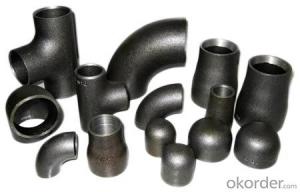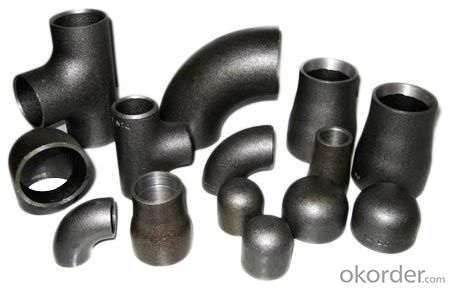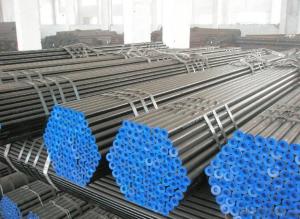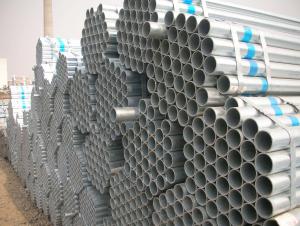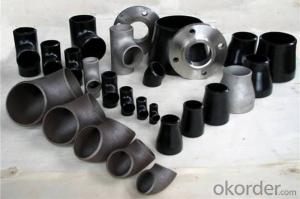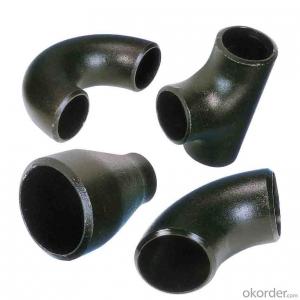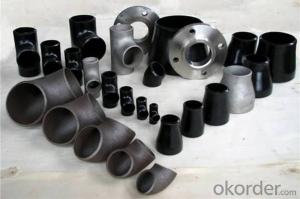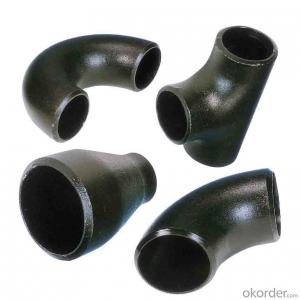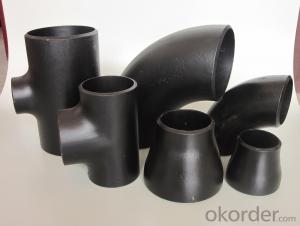32'' ELBOW TEE BEND FLANGE CARBON STEEL FITTINGS
- Loading Port:
- Tianjin
- Payment Terms:
- TT OR LC
- Min Order Qty:
- 5 m.t
- Supply Capability:
- 300 m.t/month
OKorder Service Pledge
OKorder Financial Service
You Might Also Like
Products Detailed Description
Products | pipe fittings elbows, bends,tees, reducers caps |
Size | 1/2" - 48" |
Wall thickness | Sch5-Sch160 XXS |
Standard | ANSI, ASME API5L, OCT, DIN and JIS, etc. |
we can also produce according to drawing and standards provided by customers. | |
Material | Carbon steel, alloy steel and stainless steel. |
We can produce according to materials appointed by consumers. | |
Packaging | Plywood Cases,plywood pallet, plastic bag or as customers requirement |
Surface Treatment | Shot blasted, rust-proof black oil |
Delivery Time | 10-60 days |
Quality | First grade |
Others | 1.Special design available according to your drawing. |
2.anti-corrosion and high-temperature resistant with black painting | |
3. All the production process are made under the ISO9001:2000 strictly. | |
4. A conformity rate of ex-factory inspection of products. |
Specifications
Ansi B16.9 WPB carbon steel pipe fitting elbow tee reducer
Size:Seamless 1/2"-24" Welded 1/2"-48"
ANSI B16.9 WPB carbon steel pipe fitting elbow tee reducer
1.Size: Seamless 1/2"-24" Welded 1/2"-48"
2. WT: SGP, STD, SCH40, SCH80, SCH100,SCH120,SCH160,XS,XXS
3. Material:
stainless steel Grade: 201,304,304L,316,316L,317,317L,904L,and etc
carbon steel Grade: WPB,GRB, Q235,16MN
Alloy steel: st35.8,st52,wp11,wp22,wp12 wp l6
4. Standard: ASTM/AISI/DIN/JIS
5. Type: Concentric and eccentric
6. Surface treatment: Transparent oil, rust-proof black oil
7. Applications range: Applications range: for use in the petroleum, smelting, foodstuff, power, papermaking, chemical, medical equipment,aviation, boiler heat exchanger, and other fields
8. Packing: wooden case or as per customers' requirement
- Q: Can steel pipes be used in earthquake-prone areas?
- Yes, steel pipes can be used in earthquake-prone areas. Steel has high tensile strength and can withstand seismic forces better than other materials. Additionally, steel pipes can be designed to be flexible and resistant to bending and cracking during earthquakes, making them a suitable choice for infrastructure in such areas.
- Q: How are steel pipes tested for quality?
- Steel pipes are tested for quality through various methods such as visual inspection, dimensional measurement, mechanical testing, and non-destructive testing. Visual inspection ensures that there are no surface defects or deformities on the pipes. Dimensional measurement involves checking the pipe's size, thickness, and length to meet the required specifications. Mechanical testing involves subjecting the pipes to stress, pressure, and temperature to assess their strength and durability. Non-destructive testing techniques like ultrasonic, radiographic, or magnetic particle testing are used to detect any internal flaws or defects without damaging the pipes. These comprehensive quality tests ensure that steel pipes meet the necessary standards before they are used in various applications.
- Q: How are steel pipes used in the manufacturing of pressure vessels?
- Steel pipes are commonly used in the manufacturing of pressure vessels due to their high strength and ability to withstand high pressure. These pipes are utilized as the primary material for constructing the shell of the pressure vessel, providing a robust and reliable structure. Additionally, steel pipes offer excellent resistance to corrosion, making them suitable for various industries and applications where pressure vessels are required, such as oil and gas, chemical processing, and power generation.
- Q: What are the different methods of non-destructive testing for steel pipes?
- There are several methods of non-destructive testing for steel pipes, including ultrasonic testing, magnetic particle testing, liquid penetrant testing, radiographic testing, and eddy current testing. These methods help to detect any defects or anomalies in the pipes without causing any damage, ensuring their structural integrity and reliability.
- Q: Can steel pipes be used for transporting drinking water?
- Yes, steel pipes can be used for transporting drinking water. However, it is important to ensure that the steel pipes are properly coated and protected to prevent any corrosion or leaching that could contaminate the water. Additionally, regular maintenance and monitoring of water quality should be conducted to ensure the safety of the drinking water.
- Q: Can steel pipes be used for underground sprinkler systems?
- Indeed, underground sprinkler systems can utilize steel pipes. Renowned for their durability and strength, steel pipes prove to be a fitting choice for underground applications. Their resistance to corrosion and ability to withstand high pressure and temperature render them suitable for conveying water to sprinkler heads. Nonetheless, it is crucial to acknowledge that steel pipes may necessitate supplementary coatings or protective measures to prevent rusting and corrosion in the long run. Moreover, the cost factor should be taken into account as steel pipes may be pricier compared to alternative materials like PVC or polyethylene. All in all, steel pipes can serve as a feasible option for underground sprinkler systems, particularly in regions with more severe environmental conditions.
- Q: How are steel pipes used in oil and gas industry?
- Steel pipes are widely used in the oil and gas industry for various applications. They serve as the primary means of transporting oil and gas from production sites to refineries and distribution centers. Steel pipes are also used for drilling operations, providing a conduit for drilling fluids and facilitating the extraction process. Additionally, they are utilized in the construction of storage tanks, offshore platforms, and pipelines, ensuring the safe and efficient transportation of oil and gas across long distances.
- Q: Can steel pipes be used for electrical conduit systems?
- No, steel pipes cannot be used for electrical conduit systems as they are conductive and can pose a safety risk. Non-metallic conduits, such as PVC or fiberglass, are commonly used for electrical wiring to ensure insulation and protect against electrical hazards.
- Q: How are steel pipes classified according to their use?
- Steel pipes can be classified according to their use into various categories such as structural pipes, plumbing pipes, oil and gas pipes, and industrial pipes.
- Q: What are the common standards for steel pipe manufacturing?
- The common standards for steel pipe manufacturing include specifications set by organizations such as the American Society for Testing and Materials (ASTM), the International Organization for Standardization (ISO), and the American National Standards Institute (ANSI). These standards cover various aspects such as size, dimensions, material properties, manufacturing process, and testing requirements to ensure the quality and consistency of steel pipes.
Send your message to us
32'' ELBOW TEE BEND FLANGE CARBON STEEL FITTINGS
- Loading Port:
- Tianjin
- Payment Terms:
- TT OR LC
- Min Order Qty:
- 5 m.t
- Supply Capability:
- 300 m.t/month
OKorder Service Pledge
OKorder Financial Service
Similar products
Hot products
Hot Searches
Related keywords
